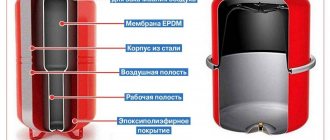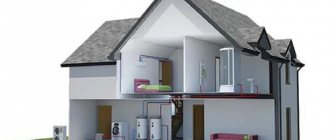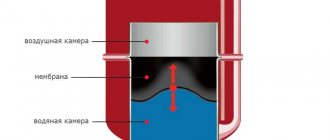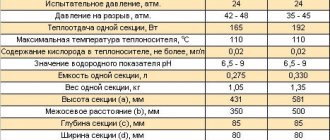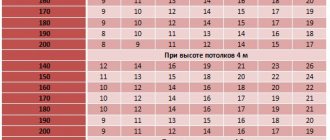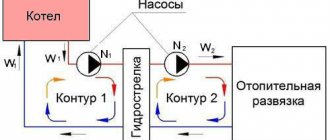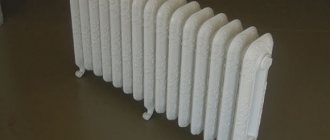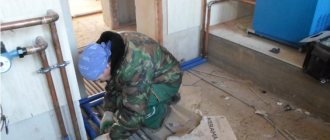How to correctly determine the type of heating boiler and calculate its power
In the heating system, the boiler plays the role of a heat generator
When choosing between boilers - gas, electric, liquid or solid fuel, pay attention to the efficiency of its heat transfer, ease of operation, and take into account what type of fuel predominates in the place of residence
The efficient operation of the system and a comfortable room temperature directly depend on the power of the boiler. If the power is low, the room will be cold, and if the power is too high, fuel will be wasted. Therefore, it is necessary to choose a boiler with optimal power, which can be calculated quite accurately.
When calculating it, you must take into account:
- area of the heated room (S);
- specific boiler power per ten cubic meters of room. It is set with adjustments taking into account the climatic conditions of the region of residence (W spec.).
There are established specific power values (Wsp.) for certain climatic zones, which are for:
- Southern regions - from 0.7 to 0.9 kW;
- Central regions - from 1.2 to 1.5 kW;
- Northern regions - from 1.5 to 2.0 kW.
Boiler power (Wbot) is calculated using the formula:
W cat. = S*W beat. / 10
Therefore, it is customary to choose the boiler power at the rate of 1 kW per 10 kW. m of heated room.
Not only the power, but also the type of water heating will depend on the area of the house. A heating design with natural water movement will not be able to effectively heat a house with an area of more than 100 square meters. m (due to low inertia). For a room with a large area, you will need a heating system with circular pumps, which will push and accelerate the flow of coolant through the pipes.
Since the pumps operate in non-stop mode, they are subject to certain requirements - noiselessness, low energy consumption, durability and reliability. On modern models of gas boilers, the pumps are already built directly into the housing.
Features of selecting a circulation pump
The pump is selected according to two criteria:
- The amount of pumped liquid, expressed in cubic meters per hour (m³/h).
- Pressure expressed in meters (m).
With pressure, everything is more or less clear - this is the height to which the liquid must be raised and is measured from the lowest to the highest point or to the next pump, if the project provides more than one.
Expansion tank volume
Everyone knows that liquid tends to increase in volume when heated. To prevent the heating system from looking like a bomb and leaking at all the seams, there is an expansion tank into which the displaced water from the system is collected.
What size tank should I purchase or make?
Everything is simple, knowing the physical characteristics of water.
We multiply the calculated volume of coolant in the system by 0.08. For example, for 100 liters of coolant, the expansion tank will have a volume of 8 liters.
Let's talk about the amount of pumped liquid in more detail.
Water consumption in the heating system is calculated using the formula:
G = Q / (c * (t2 - t1)), where:
- G – water consumption in the heating system, kg/sec;
- Q – amount of heat compensating for heat loss, W;
- c is the specific heat capacity of water, this value is known and equal to 4200 J/kg*ᵒC (note that any other coolants have worse performance compared to water);
- t2 – temperature of the coolant entering the system, ᵒС;
- t1 – coolant temperature at the outlet of the system, ᵒС;
Recommendation! For comfortable living, the temperature delta of the coolant at the inlet should be 7-15 degrees. The floor temperature in the “warm floor” system should not be more than 29 ᵒ
C. Therefore, you will have to figure out for yourself what type of heating will be installed in the house: will there be radiators, “warm floor” or a combination of several types.
The result of this formula will give the coolant consumption per second of time to replenish heat loss, then this indicator is converted into hours.
Advice! Most likely, the temperature during operation will vary depending on the circumstances and season, so it is better to immediately add 30% of the reserve to this indicator.
Let's consider the indicator the calculated amount of heat required to compensate for heat losses.
Perhaps this is the most complex and important criterion, requiring engineering knowledge, which must be approached responsibly.
If this is a private house, then the indicator can vary from 10-15 W/m² (such indicators are typical for “passive houses”) to 200 W/m² or more (if it is a thin wall with no or insufficient insulation).
In practice, construction and trade organizations take the heat loss indicator as a basis - 100 W/m².
Recommendation: calculate this indicator for a specific house in which a heating system will be installed or reconstructed. For this, heat loss calculators are used, with losses for walls, roofs, windows, and floors being calculated separately. These data will make it possible to find out how much heat a house physically releases into the environment in a specific region with its own climate regimes.
We multiply the calculated loss figure by the area of the house and then substitute it into the water consumption formula.
Now you need to deal with the issue of water consumption in the heating system of an apartment building.
Water volume of the coolant in the pipe and radiator, how is it calculated
The water volume or heat carrier in a wide variety of pipelines, for example, low-pressure polymer ethylene (HDPE pipe), polypropylene pipes, metal-plastic pipes, profile pipes, is important to know when choosing some equipment, especially an expansion tank. For example, in a metal-plastic pipe with a diameter of 16 per meter of pipe 0.115 g
coolant
For example, in a metal-plastic pipe the diameter is 16 per meter of pipe 0.115 g. heat carrier.
Did you know? There is no faster way. And why do you actually need to know this until you are faced with a choice, for example, an expansion tank. Knowing the volume of coolant in the heating system is necessary not only to select an expansion tank, but also to purchase antifreeze. Antifreeze is sold undiluted to -65 degrees and diluted to -30 degrees. Once you know the volume of coolant in the heating system, you will be able to purchase an equal amount of antifreeze. For example, undiluted antifreeze needs to be diluted 50*50 (water*antifreeze), which means with a volume of coolant equal to 50 liters, you will need to purchase only 25 liters of antifreeze.
We recommend for you a form for calculating the volume of water (heat carrier) in the water supply and heating radiators. Enter the length of a pipe of a specific diameter and instantly find out how much coolant is in this section.
Water volume in pipes of different diameters: performing calculations
Once you have calculated the volume of coolant in the water metering unit, however, to create a complete picture, and specifically to find out the entire volume of coolant in the system, you will also need to calculate the volume of coolant in the heating radiators.
Volumetric calculation of water in pipes
Volumetric calculation of water in a heating radiator
Water volume in certain metal batteries
Now it certainly won’t be difficult for you to calculate the volume of coolant in the heating system.
Volumetric calculation of the coolant in heating radiators
In order to calculate the entire volume of the coolant in the heating system, we also need to add the water volume in the boiler. You can find it out in the boiler passport or take approximate numbers:
floor boiler - 40 liters of water;
mounted boiler - 3 liters of water.
A brief guide to using the calculator “Volume calculation of water in a wide variety of pipelines”:
- in the first list, select the pipe material and its diameter (it can be plastic, polypropylene, metal-plastic, steel and diameters from 15 - ...)
- in another list we write the footage of the selected pipe from the first list.
- Click “Calculate”.
“Calculate the amount of water in heating radiators”
- in the first list, select the interaxial distance and what materials the heating device is made of.
- enter the number of sections.
- Click “Calculate”.
Heating 'target=»_blank»>')
Calculation of coolant volume in pipes and boiler
Heating system components
The starting point for calculating the technical characteristics of the components is to calculate the volume of water in the heating system. In fact, it is the sum of the capacity of all elements, from the boiler heat exchanger to the batteries.
How to calculate the volume of a heating system yourself, without involving specialists or using special programs? To do this, you will need a diagram of the location of the components and their overall characteristics. The total capacity of the system will be determined by these parameters.
Volume of water in the pipeline
A significant part of the water is located in pipelines. They occupy a large part in the heat supply scheme. How to calculate the volume of coolant in a heating system, and what characteristics of pipes do you need to know for this? The most important of them is the diameter of the line. It is he who will determine the water capacity in the pipes. To calculate, just take the data from the table.
| Pipe diameter, mm | Capacity l/p.m. |
| 20 | 0,137 |
| 25 | 0,216 |
| 32 | 0,353 |
| 40 | 0,555 |
| 50 | 0,865 |
Pipes of various diameters can be used in the heating system. This is especially true for collector circuits. Therefore, the volume of water in the heating system is calculated using the following formula:
Vtotal=Vtr1*Ltr1+ Vtr2*Ltr2+ Vtr2*Ltr2…
Where Vtotal is the total capacity of water in the pipelines, l, Vtr is the volume of coolant in 1 m.p. pipes of a certain diameter, Ltr – the total length of the pipeline with a given cross-section.
In total, these data will allow you to calculate most of the volume of the heating system. But in addition to pipes, there are other heating components.
For plastic pipes, the diameter is calculated based on the dimensions of the outer walls, and for metal pipes, based on the inner walls. This can be significant for thermal systems with a large extent.
Calculation of heating boiler volume
Heat exchanger of the heating boiler
The correct volume of the heating boiler can only be found out from the data in the technical passport. Each model of this heating device has its own unique characteristics, which are often not repeated.
A floor-standing boiler can have large dimensions. This is especially true for solid fuel models. In fact, the coolant does not occupy the entire volume of the heating boiler, but only a small part of it. All liquid is located in a heat exchanger - a structure necessary to transfer thermal energy from the fuel combustion zone to water.
If the instructions from the heating equipment have been lost, the approximate capacity of the heat exchanger can be used for calculations. It depends on the power and model of the boiler:
- Floor-standing models can hold from 10 to 25 liters of water. On average, a 24 kW solid fuel boiler contains about 20 liters in the heat exchanger. coolant;
- Wall-mounted gas ones are less spacious - from 3 to 7 liters.
Taking into account the parameters for calculating the volume of coolant in the heating system, the capacity of the boiler heat exchanger can be neglected. This figure varies from 1% to 3% of the total heat supply to a private home.
Without periodic heating cleaning, the cross-section of the pipes and the flow diameter of the batteries are reduced. This affects the actual capacity of the heating system.
Coolant flow in the heating system
The flow rate in the coolant system implies the mass amount of coolant (kg/s) intended to supply the required amount of heat to the heated room. The calculation of the coolant in the heating system is determined as the quotient of dividing the calculated heat demand (W) of the room (rooms) by the heat transfer of 1 kg of heating fluid (J/kg).
Some tips for filling the heating system with coolant in the video:
The coolant flow in the system during the heating season in vertical central heating systems changes, since they are regulated (this is especially true for the gravitational circulation of the coolant - in more detail: “Calculation of the gravitational heating system of a private house - diagram”). In practice, in calculations, coolant flow is usually measured in kg/h.
Technical aspects of aluminum batteries
To install an autonomous heating system, it is necessary not only to carry out installation work in accordance with current regulations, but also to choose the right aluminum radiators. This can only be done after a thorough study and analysis of their properties, design features, and technical characteristics.
Classification and design features
Manufacturers of modern heating equipment make sections of aluminum radiators not from pure aluminum, but from its alloy with silicon additives. This allows the products to be corrosion resistant, more durable and extend their service life.
Today, the retail chain offers a wide range of aluminum radiators, differing in appearance, represented by such products as:
- panel;
- tubular.
According to the constructive solution of a single section, which are:
- Solid or cast.
- Extruded or composed of three separate elements, internally secured to each other with bolts with foam rubber or silicone gaskets.
Batteries are also differentiated by size.
Standard sizes with a width of 40 cm and a height of 58 cm.
Low, up to 15 cm high, which makes it possible to install them in very limited spaces. Recently, manufacturers have been producing aluminum radiators of this series of “plinth” design with a height of 2 to 4 cm.
Tall or vertical. With a small width, such radiators can reach a height of up to two or three meters. This working height arrangement helps to heat large volumes of air in the room quite effectively. In addition, this original design of radiators also performs a decorative function.
The service life of modern aluminum radiators is determined by the quality of the source material and does not depend on the number of its constituent elements, their sizes and internal volume. The manufacturer guarantees their stable operation with proper use for up to 20 years.
Main performance characteristics
Comparative characteristics
Technical characteristics and design solutions of aluminum radiators are developed to ensure convenient and reliable heating of rooms. The main components characterizing their technical properties and operational capabilities are the following factors.
Operating pressure. Modern aluminum radiators are designed for pressure levels from 6 to 25 atmospheres. To guarantee these indicators, in the factory, each battery is tested at a pressure of 30 atmospheres. This fact makes it possible to install this heating equipment in any heating system where the possibility of water hammer formation is excluded.
Power. This indicator characterizes the thermodynamic process of heat transfer from the surface of the heating battery to the environment. It indicates how much heat in watts the device can produce per unit time.
By the way, it occurs using the method of convection and thermal radiation in a ratio of 50 to 50. The numerical value of the heat transfer parameter of each section is indicated in the device passport.
When calculating the number of batteries required for installation, their power plays a primary role. The maximum heat transfer of one section of an aluminum heating radiator is quite high and reaches 230 Watts. This impressive figure is explained by the high heat transfer ability of aluminum.
This means that it requires less energy to heat it than its cast iron counterpart.
The temperature range for heating the coolant in aluminum batteries exceeds 100 degrees.
As a reference, a standard section of an aluminum radiator with a height of 350–1000 mm, a depth of 110–140 mm, with a wall thickness of 2 to 3 mm, has a coolant volume of 0.35–0.5 liters, and is capable of heating an area of 0.4– 0.6 square meters.
Antifreeze parameters and types of coolants
The basis for the production of antifreeze is ethylene glycol or propylene glycol. In their pure form, these substances are very aggressive media, but additional additives make antifreeze suitable for use in heating systems. The degree of anti-corrosion, service life and, accordingly, the final cost depend on the additives introduced.
The main task of additives is protection against corrosion. Having low thermal conductivity, the rust layer becomes a heat insulator. Its particles contribute to clogging of channels, disable circulation pumps, and lead to leaks and damage in the heating system.
Moreover, the narrowing of the internal diameter of the pipeline entails hydrodynamic resistance, due to which the speed of the coolant decreases and energy consumption increases.
Antifreeze has a wide temperature range (from -70°C to +110°C), but by changing the proportions of water and concentrate, you can obtain a liquid with a different freezing point. This allows you to use intermittent heating mode and turn on room heating only when necessary. As a rule, antifreeze is offered in two types: with a freezing point of no more than -30°C and no more than -65°C.
In industrial refrigeration and air conditioning systems, as well as in technical systems with no special environmental requirements, ethylene glycol-based antifreeze with anti-corrosion additives is used. This is due to the toxicity of the solutions. Their use requires closed expansion tanks; use in double-circuit boilers is not allowed.
A solution based on propylene glycol received other possibilities for use. This is an environmentally friendly and safe composition that is used in the food, perfume industry and residential buildings. Wherever it is necessary to prevent toxic substances from entering the soil and groundwater.
The next type is triethylene glycol, which is used at high temperatures (up to 180°C), but its parameters have not led to widespread use.
Calculation of coolant volume
Why do you need to calculate the optimal amount of coolant?
An incorrect volume of coolant negatively affects many elements of equipment. If it is small, then the energy converted into heat will not be transferred to the liquid, but to the housings of the heating elements. Overheating can damage the equipment for a long time, or even lead to its complete loss.
Also, if there is a lack of coolant, air takes its place. In heating systems, it is important to exclude the presence of air in the circuit, since it not only reduces the concentration of the coolant itself and, accordingly, reduces the efficiency of the system, but also leads to oxidation of materials, which leads to corrosion and subsequent breakdowns.
In turn, if there is too much coolant, the pressure will be exceeded during heating. At best, this will lead to broken valves, breakthroughs in the system, numerous leaks and even explosions.
These facts are enough to understand the importance of correct calculation of the coolant, because this will save you from many problems in the form of downtime, financial and time costs, repair and replacement of equipment, as well as vegetating in the cold.
Formula for calculating coolant volume
Since the presence of air in the heating equipment circuit reduces thermal conductivity and negatively affects performance, it is necessary to correctly calculate the amount of coolant. To do this, you need to sum up the internal volume of all elements of the system intended to contain it.
Typically, the heating system consists of the following parts:
- Expansion tank
- Heating boiler
- Connecting pipes
- Radiators
In some cases, reserve coolant tanks are also used to compensate for fluid evaporation, but they are not used in calculating system volume.
Formula for calculating the volume of a heating system
V system = V expansion tank + V boiler + V all pipes + V all radiators
If you purchase certified equipment, the volumes of all elements must be indicated in the technical documentation, but the length and, accordingly, the volume of pipes always depends on the specific room and system, so they will have to be counted manually. To do this, it is necessary to multiply the cross-section (S) of the pipe by its length (L). The cross section itself is calculated by multiplying the internal radius of the pipe (R) by the mathematical constant Pi (π) equal to 3.14.
Formula for calculating pipe volume
V pipe = S*L
or
V pipes = R*π*L
Now, knowing the volume of your heating system, you need to fill it with the appropriate amount of coolant. But there is a certain nuance here. As you know, any materials expand when heated, therefore, when the circuit is completely filled during the heating of the filler, the valves can burst and the lids can come off.
To avoid this, the coefficient of expansion of the liquid at a certain temperature should be taken into account. Thus, ethylene glycol at 40°C will increase its volume by 0.75%, and at 110°C by 5.15%. The expansion coefficients of each coolant can be found in the technical documentation or checked with the manufacturer. Having the information received, you can adjust the volume of liquid.
Example of calculating coolant volume
Let's assume that your room is heated using one standard steel radiator with 10 sections (each section holds 0.45 liters). A heating boiler with a capacity of 10 liters is located in the next room 5 meters in a straight line from it, and they are connected by a standard pipe with an internal radius of 15 mm. The expansion tank has a capacity of 0.5 liters.
We get:
V pipe = 0.15*3.14*5 = 2.35 liters
Radiator V = 0.45*10 = 4.5 liters
V system = 2.35+4.5+10+0.5 = 17.35 liters
But this is not the end. 17.35 liters is the capacity of the system itself, while when heated, the volume of coolant will increase. Let's say for heating we use the above-mentioned ethylene glycol, heated to the same 110°C, accordingly its amount will increase by 5.15%. We reduce this volume by this factor:
17.35*(100-5.15)/100 = 16.45 liters
Note: if we fill our system with 16.45 liters of ethylene glycol and it increases by 5.15%, then we will only get 17.3 liters, but 50 ml of volume can be considered a technical error and this volume of air is too small to harm the equipment.
This is exactly how much ethylene glycol is needed for our system. Since the possibility of leaks can never be ruled out, and taking into account the evaporation of liquid, it is worth buying with a reserve.
Types of radiators
The most popular among the total number of convectors are three types:
- Aluminum radiator;
- Cast iron battery;
- Bimetallic radiator.
If you know which convector is installed in your home and are able to count the number of sections, then making simple calculations will not be difficult. Next, calculate the volume of water in the heating radiator
,
table
and all necessary data are presented below. They will help to calculate as accurately as possible the amount of coolant in the entire system.
| Convector type | Average water volume liter/section |
| Aluminum | |
| Old cast iron | |
| New cast iron |
Bimetallic
Aluminum
Although in some cases the internal heating system of each battery may differ, there are generally accepted parameters that allow you to determine the amount of liquid placed in it. With a possible error of 5% you will learn that one section of an aluminum radiator can contain up to 450 ml of water
It is worth paying attention to the fact that for other coolants the volumes may be increased
Cast iron
Calculating the amount of liquid that fits in a cast iron radiator is a little more difficult. An important factor will be the novelty of the convector. New imported radiators have significantly less void space, and due to their improved structure, they heat no worse than the old ones.
The new cast iron convector holds about 1 liter of liquid, the old one will hold 700 ml more.
Bimetallic
These types of radiators are quite economical and productive. The reason why filling volumes may change lies only in the features of a particular model and pressure variation. On average, such a convector is filled with 250 ml of water.
Possible changes
Each battery manufacturer sets its own minimum/maximum permissible standards, but the volume of coolant in the internal tubes of each model may change due to pressure increase considerations. Typically, in private homes and new buildings, an expansion tank is installed on the ground floor, which allows the liquid pressure to be stabilized even when it expands when heated.
Parameters also change on outdated radiators. Often, even on non-ferrous metal tubes, growths form due to internal corrosion. The problem may be impurities in the water.
Due to such growths in the tubes, the amount of water in the system must be gradually reduced. Taking into account all the features of your convector and the general data from the table, you can easily calculate the required volume of water for the heating radiator and the entire system.
The circulation pump is selected based on two main characteristics:
G* - flow rate, expressed in m 3 / hour;
H - pressure expressed in m.
*To record coolant flow, manufacturers of pumping equipment use the letter Q. Manufacturers of shut-off valves, for example, Danfoss, use the letter G to calculate flow. In domestic practice, this letter is also used. Therefore, within the framework of the explanations of this article, we will also use the letter G. But in other articles, going directly to the analysis of the pump operation schedule, we will still use the letter Q for flow rate.
3.1.General information
The heat demand of heat-using consumers varies depending on meteorological conditions, the number of people using hot water in domestic hot water supply systems, and the modes of air conditioning and ventilation systems for heating units. For heating, ventilation and air conditioning systems, the main factor influencing heat consumption is the outside air temperature. The heat consumption supplied to cover the loads of hot water supply and technological consumption does not depend on the outside air temperature.
The technique of changing the amount of heat supplied to consumers in accordance with their heat consumption schedules is called a heat supply control system.
There are central, group and local regulation of heat supply.
One of the most important tasks in regulating heat supply systems is calculating operating schedules for various load control methods.
Regulation of the heat load is possible using several methods: changing the temperature of the coolant - a qualitative method; periodic shutdown of systems – intermittent regulation; change in the surface of the heat exchanger.
In heating networks, as a rule, central quality control is adopted for the main heat load, which is usually the heating load of small and public buildings. Central qualitative regulation of heat supply is limited by the lowest water temperatures in the supply pipeline necessary to heat the water entering the hot water supply systems of consumers:
for closed heating systems - at least 70°C;
for open heat supply systems - at least 60°C.
Based on the data obtained, a graph of changes in the temperature of the network water is constructed depending on the outside air temperature. It is advisable to perform a temperature graph on a sheet of A4 graph paper or using Microsoft Office Excel. The graph determines the control ranges based on the break point temperature and describes them.
2.3.2
.
Central quality regulation for heating load
Central quality regulation for heating load is advisable if the heat load for housing and communal needs is less than 65% of the total load of the area and with the ratio
.
With this method of regulation, for dependent connection schemes of elevator heating systems, the temperature of the water in the supply
and reverse
highways, as well as after the elevator
during the heating season is determined by the following expressions:
(2)
The calculation was made for value No. 1. For all others, the calculation was made using the formula proposed above; the results are listed in Table 3.
(3)
The calculation was made for value No. 1. For all others, the calculation was made using the formula proposed above; the results are listed in Table 3.
where t
— calculated temperature pressure of the heating device, 0 C, determined by the formula:
, (4)
Here
3 and
2 - calculated water temperatures, respectively, after the elevator and in the return line of the heating network, determined at
(for residential areas, as a rule,
3 = 95 0 C;
2 = 70 0 C);
— calculated temperature difference of supply water in the heating network
=
1 —
2 (5)
=110-70=40
- calculated temperature difference of network water in the local heating system,
(6)
Given different values of outside air temperatures t
n (usually
t
n = +8; 0; -10;
t
nr v;
t
nro) determine
01;
02 ;
03 and build a heating graph of water temperatures.
To satisfy the hot water supply load, the water temperature in the supply line
01 cannot be lower than 70 0 C in closed heating systems. To do this, the heating schedule is straightened at the level of the indicated temperatures and becomes a heating-domestic one (see example solution).
Outdoor air temperature corresponding to the break point of the water temperature graphs t
n ", divides the heating period into ranges with different control modes:
in range I with the range of outside air temperatures from +8 0 C to t
n “group or local regulation is carried out, the task of which is to prevent “overheating” of heating systems and unnecessary heat losses;
in ranges II and III with the range of outside air temperatures from t
n » to
t
nro central quality regulation is carried out.
Table 3 - Temperature graph
| Outside air temperature, tnr | Coolant temperature |
Correct calculation of the coolant in the heating system
Based on a set of characteristics, the undisputed leader among coolants is ordinary water. It is best to use distilled water, although boiled or chemically treated water is also suitable - to precipitate the salts and oxygen dissolved in the water.
However, if there is a possibility that the temperature in a room with a heating system will drop below zero for some time, then water will not be suitable as a coolant. If it freezes, then with an increase in volume there is a high probability of irreversible damage to the heating system. In such cases, a coolant based on antifreeze is used.
How to calculate the expansion coefficient
When calculating the volume of a heating system, you should pay attention to the expansion coefficient of the liquid used as a coolant. This parameter can be characterized by two values, depending on the type of heating equipment being installed.
In the case when water is used as a coolant in the heating system, then the expansion coefficient is 4%, and if ethylene glycol is 4.4%.
There are other, less accurate ways to calculate the volume of a heating system. For example, you can use the power indicator of the heating unit: it is assumed that 1 kW corresponds to 15 liters of coolant. Thus, in order to find out the approximate capacity of all elements of the heating structure, it is necessary to know the power of the heating system.
It is imperative to take into account that the installation of modern elements of the heating system, such as radiators, pipes, and a boiler, to some extent contribute to reducing its total volume. Detailed information regarding the capacity of the heating radiator or other components of the heating structure is contained in the technical documentation supplied by manufacturers to their products.
General calculations
It is necessary to determine the total heating capacity so that the power of the heating boiler is sufficient for high-quality heating of all rooms. Exceeding the permissible volume can lead to increased wear of the heating device, as well as significant energy consumption.
The required amount of coolant is calculated according to the following formula: Total volume = V boiler + V radiators + V pipes + V expansion tank
Boiler
Calculating the power of the heating unit allows you to determine the boiler capacity indicator. To do this, it is enough to take as a basis the ratio in which 1 kW of thermal energy is enough to effectively heat 10 m2 of living space. This ratio is fair in the presence of ceilings whose height is no more than 3 meters.
As soon as the boiler power indicator becomes known, it is enough to find a suitable unit in a specialized store. Each manufacturer indicates the volume of equipment in the passport data.
Therefore, if the correct power calculation is performed, there will be no problems with determining the required volume.
To determine the sufficient volume of water in the pipes, it is necessary to calculate the cross-section of the pipeline according to the formula - S = π × R2, where:
- S – cross section;
- π is a constant equal to 3.14;
- R is the inner radius of the pipes.
Having calculated the cross-sectional area of the pipes, it is enough to multiply it by the total length of the entire pipeline in the heating system.
Expansion tank
You can determine what capacity the expansion tank should have by having data on the coefficient of thermal expansion of the coolant. For water this indicator is 0.034 when heated to 85 °C.
When performing the calculation, it is enough to use the formula: V-tank = (V system × K) / D, where:
- V-tank - the required volume of the expansion tank;
- V-syst - the total volume of liquid in the remaining elements of the heating system;
- K – expansion coefficient;
- D – efficiency of the expansion tank (indicated in the technical documentation).
Currently, there is a wide variety of individual types of radiators for heating systems. In addition to functional differences, they all have different heights.
To calculate the volume of working fluid in radiators, you must first count their number. Then multiply this amount by the volume of one section.
You can find out the volume of one radiator using the data from the product technical data sheet. In the absence of such information, you can navigate according to average parameters:
- cast iron - 1.5 liters per section;
- bimetallic - 0.2-0.3 l per section;
- aluminum - 0.4 l per section.
The following example will help you understand how to correctly calculate the value. Let's say there are 5 radiators made of aluminum. Each heating element contains 6 sections. We make the calculation: 5 × 6 × 0.4 = 12 liters.
As you can see, calculating the heating capacity comes down to calculating the total value of the four above elements.
Not everyone can determine the required capacity of the working fluid in a system with mathematical accuracy. Therefore, not wanting to perform the calculation, some users act as follows. To begin with, fill the system to approximately 90%, after which the functionality is checked. Next, the accumulated air is released and filling continues.
During operation of the heating system, a natural decline in the coolant level occurs as a result of convection processes. In this case, there is a loss of power and productivity of the boiler. This implies the need to have a reserve tank with working fluid, from where it will be possible to monitor the loss of coolant and, if necessary, replenish it.
Filling a closed heating system
Here, it is most convenient to carry out the filling process using a pump connected to the system’s replenishment fitting. If there is no pump, then you will have the grueling job of pouring antifreeze through the highest point by unscrewing the automatic air vent. It is also advisable that an assistant participate in the operation. Its job is to release air from the batteries while you are pumping antifreeze into the boiler room. Before starting work, make sure that:
- all shut-off valves are open;
- the boiler shut-off valves are closed;
- the concentrate is diluted according to the instructions;
- Mayevsky relief valves are closed;
- the valve shutting off the membrane expansion tank is open.
The process begins with pumping antifreeze until the pressure gauge shows a pressure of 1.4-1.5 bar. After this, you need to give a signal to the assistant to gradually release air from the radiators, starting with the lowest ones. At this time, you need to monitor the drop in pressure on the pressure gauge and slowly pump up the coolant so that it does not fall below 1 bar.
Note. In closed heating systems, there must be a spring-type check valve on the make-up connection, otherwise it will be difficult to pump antifreeze or water into it.
When all the air has been successfully released, the antifreeze is pumped back in to a pressure of 1.5 Bar. Then you need to open the valves that shut off the boiler one by one - first on the return line, and then on the supply line. Open the second tap slowly so that the air has time to escape through the automatic air vent, which is located on the boiler safety group. In this case, the pressure will begin to drop again, and you will have to immediately pump up the antifreeze.
When starting the heat generator and warming up the coolant, you need to monitor the pressure gauge readings. As a result, they should not exceed 1.8 Bar at operating temperature. The last stage is re-venting the air from the heating devices and adjusting the pressure. You need to work with Mayevsky taps carefully and carefully so as not to get burned or spill antifreeze, especially when you poured ethylene glycol into the system.
Advice. At the end of the process, carefully inspect all connections and equipment for antifreeze leaks. If these are detected, it is not necessary to empty all the pipelines again; you can cut off a separate branch or radiator with fittings, and after eliminating, raise the pressure again and bleed off the air.
The amount of coolant in the heating system
Coolant is needed after installing a new heating system, after its repair or reconstruction.
Before filling the heating system, it is necessary to determine the exact amount of coolant in order to purchase or prepare the required volume in advance. It is necessary to collect information about the certified volume of all heating devices and pipelines (for more details: “Calculation of the volume of the heating system, including radiators”). Typically, such data is contained on the packaging or in reference literature. The volume of pipes is easily calculated based on their length and known cross-section. For the most common elements of heating networks, the volumes of coolant are as follows:
- Section of a modern radiator (aluminum, steel or bimetallic) - 0.45 liters
- Radiator section of the old type (cast iron, MS 140-500, GOST 8690-94) – 1.45 liters
- Linear meter of pipe (15 mm internal diameter) - 0.177 liters
- Linear meter of pipe (32 mm internal diameter) - 0.8 liters
It is not enough for us to calculate the coolant flow - the formula for calculating the volume of the expansion tank is also absolutely necessary. It is not enough to simply sum up the volumes of the components of the heating network (radiators, boiler and pipelines). The fact is that during the heating process of the original liquid, the volume of the liquid changes significantly, and therefore the pressure increases. In order to compensate for this, so-called expansion tanks are used.
Their volume is calculated using the following indicators and coefficients:
E is the so-called expansion coefficient of the liquid (calculated as a percentage). It is different for different coolants. For water it is 4%, for antifreeze based on ethylene glycol - 4.4%.
d - efficiency coefficient of the expansion tank VS - calculated coolant flow (summed volume of all components of the heating system) V - calculation result. Expansion tank volume.
Calculation formula - V = (VS x E)/d
The calculation of the coolant in the heating system has been completed - it’s time to fill it up!
There are two options for filling the system, depending on its design:
- Filling by gravity
- at the highest point of the system, a funnel is inserted into the hole, through which the coolant is gradually poured. You must remember to open the tap at the lowest point of the system and substitute some kind of container. - Forced injection using a pump
. Almost any low power electric pump will do. During the filling process, you should monitor the pressure gauge readings so as not to overdo it with pressure. It is highly advisable to remember to open the air valves on the batteries.
How to pour antifreeze into an open system
This is exactly the case when you should buy safe propylene glycol. It's all about the open expansion tank communicating with the atmosphere. Since it is located within the house (usually in the attic), small amounts of fumes can enter the living spaces. In general, pouring antifreeze into an open system is not advisable. It is better to convert it into a closed one, from where it will not evaporate.
The diluted concentrate is poured through an expansion tank or make-up valve using a pump. In this case, all Mayevsky air valves installed on radiators must be open. As the tank is filled, the taps are closed, after which the coolant level is brought to approximately 1/3 of the expansion tank.
Advice. Before you pump antifreeze into the heating system of your home with your own hands, you need to make sure that all shut-off and control valves are open.
After starting and warming up the boiler, you need to bleed the air through the batteries again. If the level of heated coolant in the expansion tank has dropped, then add antifreeze to about half.
Section volume and coolant flow
Today, not all autonomous heating systems are filled with water. This is due to two factors.
Section size
- A situation arises when the owners need to leave the house without heating for a long time, since due to a long absence there is no need to heat the premises.
- Water tends to freeze even at zero temperatures. When water freezes, it expands and turns into ice, that is, it changes from one physical state to another. During this process, the intermolecular bonds of water are released and changed, resulting in a huge force that breaks radiators and pipes made of any metal.
To prevent such situations from occurring, instead of water, another coolant is used to fill the heating system, which does not have the problem of freezing. These can be household antifreezes such as:
- ethylene glycol;
- saline solution;
- glycerin composition;
- food alcohol;
- petroleum oil.
Thanks to special additives that are introduced into these components, coolant compositions retain their state of aggregation in liquid form even at subzero temperatures.
Coolant calculation
Determining the volume of coolant flow required for an autonomous heating system requires accurate calculation. For a simple way to find out how much antifreeze is needed to fill the heating system, there are various calculation tables.
Water volume in one section
For basic calculations, you can use the information presented in thematic reference books:
- A standard aluminum battery section contains 0.45 liters of coolant.
- A linear meter of a 15 mm pipe contains 0.177 liters, and a pipe with a diameter of 32 mm contains 0.8 liters of coolant.
Information about the characteristics of the charging pump and expansion tank can be taken from the passport data of this equipment.
The total volume of the heating system will be equal to the total volume of all heating devices:
- radiators;
- pipelines;
- boiler heat exchanger;
- expansion tank.
The refined formula for the main calculation is adjusted taking into account the expansion coefficient of the coolant. For water it is 4%, for ethylene glycol ─ 4.4%.
Heating calculation required
An example of a complex home heating system
First, you should determine the relevance of calculating the volume of water in the heating system or the same indicator for batteries and an expansion tank. After all, you can install these components without complex operations, guided only by personal experience and advice from professionals.
The operation of any heating system is associated with a constant change in the coolant parameters - temperature and pressure in the pipes. Therefore, calculating heating according to the volume of the building will allow you to correctly equip the heat supply based on the characteristics of the house. In addition, the direct dependence of operating efficiency on current steam meters should be taken into account. Since you can calculate the volume of water in the heating system yourself, this procedure is recommended to be performed to avoid the following situations:
- Incorrect actual thermal operating conditions that do not correspond to the calculated ones;
- Uneven heat distribution across heating appliances;
- Occurrence of emergency situations. After all, how can you calculate the volume of an expansion tank for heating if the total capacity of the pipelines and batteries is not known?
To minimize the occurrence of these situations, the volume of the heating system and its components should be calculated in a timely manner.
Calculations of heat supply parameters are carried out even before installation work. They serve as the basis for the selection of components.
